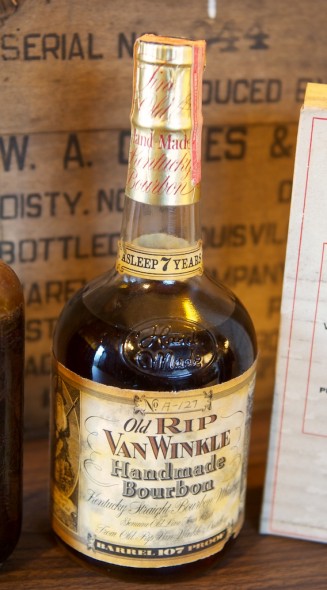Old Whiskey Romance

There they were, all dusty, label-torn and ready to drink. One bourbon was distilled in 1908, when England beat Australia by one wicket at the Melbourne Cricket Ground. Who can forget that upset? It was also the year my home state, Oklahoma, was added to the American flag. The Old Crow whiskey sat in a barrel for 17 years before it was bottled. When bourbon historian Mike Veach gingerly pried out the cork with his trusty pocketknife, this Old Crow bourbon was poured into glasses for the first time.
At the special Filson Historical Society bourbon tasting, Old Crow was followed Broad Ripple whiskey circa 1930s, Old Rip Van Winkle 7-year-old bourbon bottled in 1974 or 1975 and a bottle of trendy Angel’s Envy. In my career, I’ve tasted several brandies more than 100-years-old, but I’ve never set my lips upon American whiskey bottled before 1945. There’s a reason why, too.
Prohibition took much of our older whiskey. The older stocks were pushed into the medicinal Prohibition market, sold on the illegal market or confiscated by Revenuers. 1908 bottles of Old Crow probably didn’t last long in most people’s houses. There’s also the matter of storage.
Even if somebody kept the whiskey all these years and passed it down to family member to family member, how they stored it matters. Since cork allows in oxygen, it will also take in kitty litter or gasoline fumes if stored near such for 30 years. Then, there’s the production side. Some glassmakers in the 1800s used creosote to make glass. Veach says the creosote leaches into the whiskey. Plus, the corks were not very tight. I’ve tasted many 1950s-era whiskeys that took corky flavors after cork pieces fell into the liquid due to improper storage. After 10 years sitting in the whiskey, a tiny cork particle can ruin the whiskey.
So, even though you can purchase these old bottles on the Internet, you’re not guaranteed a great tasting experience. That’s why I put off my tequila-tasting session January 31, 2013, and went to the Filson for a one-of-a-kind tasting experience. What I tasted surprised the barley out of me.
Old Crow 17-year-old
Made by W.A. Gaines & Company
Distilled in 1908 and Bottled in Spring 1925
 Background on Old Crow: Old Crow was named after Dr. James C. Crow, a Scottish doctor who implemented scientific procedures to bourbon whiskey making. In her public whiskey hate meetings, Carrie Nation said the whiskey shames the crows, as in the birds. If only, the hatchet lady did her homework! From the 1830s to 1850s, Dr. Crow introduced thermometers, saccharometers and sanitation procedures. He redefined whiskey making, and his brand became the most popular in all the land. Although a few historians dispute this, Old Crow supposedly was the preferred bourbon for President Grant. Veach says Old Crow was the whiskey by which all others were judge. Since then, Jim Beam purchased the brand, where it plays second or third fiddle to the company’s flagship whiskey. “Jim Beam should be put on trial for what they did to Old Crow,” Veach says.
Background on Old Crow: Old Crow was named after Dr. James C. Crow, a Scottish doctor who implemented scientific procedures to bourbon whiskey making. In her public whiskey hate meetings, Carrie Nation said the whiskey shames the crows, as in the birds. If only, the hatchet lady did her homework! From the 1830s to 1850s, Dr. Crow introduced thermometers, saccharometers and sanitation procedures. He redefined whiskey making, and his brand became the most popular in all the land. Although a few historians dispute this, Old Crow supposedly was the preferred bourbon for President Grant. Veach says Old Crow was the whiskey by which all others were judge. Since then, Jim Beam purchased the brand, where it plays second or third fiddle to the company’s flagship whiskey. “Jim Beam should be put on trial for what they did to Old Crow,” Veach says.
In this 17-year-old version, we see why Old Crow was such a big deal. The complex nose is rich with caramel, toasted pecans, vanilla, cigar box and raisins. A few minutes later the whiskey opens up and the caramel becomes more pronounced with new hints of walnut, tobacco and toffee. The nose just didn’t quit, and prepared me for a whiskey that starts right on the tip of your tongue with spice and just trickles back, lining every inch with the expected notes we found in the bouquet with apple and dried apricot joining the party. After a great two-minute or so finish, I don’t want to move onto to the next whiskey. I wanted to sit by a fire and talk with my friends, Veach, and Josh Durr about why this whiskey is so awesome. Could it change as it opens up? Should we have decanted this? Alas, we cannot stay with this whiskey forever. We must move on to Broad Ripple.
Broad Ripple
Made by Four Roses
Distilled and bottled sometime in the 1930s. Veach says this was one of the last bottlings of medicinal Prohibition whiskey.
Background on Broad Ripple Whiskey: The fact is we don’t know much about this whiskey. We know it was used for the medicinal market during Prohibition, and that’s about it. I did find a 1934 judgment under the Food & Drugs Act for false and fraudulent advertising. But, we shouldn’t read too much into that. Everybody got that slap on the wrist.
Unfortunately, the FDA judgment didn’t stop this whiskey from following our wonderful Old Crow experience. When we first get a glass, whiskey critics analyze the color and how it moves. Josh Durr said, watching it slide round the glass like a snake: “This looks like glycerin.” The whiskey jumps right into your nose like a moth ball and doesn’t stop until you eventually pick up one decent quality, the hint of licorice. The taste sent Broad Ripples of old cough syrup down my throat. I gave the taste one more shot, and I can’t lie, the whiskey tasted exactly like a Moth Ball cake with Robitussin icing. My friend, the Bourbon Babe blogger, said it best: “It’s just gross.” We talked about why it was so awful, and the best theory came from the Veach: “At that time, distillers were buying up any barrels they could just to keep their brands out there.”
Thankfully, our palates were saved by a stellar bottle of Old Rip Van Winkle.

Old Rip Van Winkle 7-year-old, 107 proof
Made by Stitzel Weller Distillery, Bottled in 1974 or 1975
Distilled at 120 proof and put into the barrel around 105 to 107 proof, Old Rip Van Winkle is flat out beautiful. We’re tasting this with Julian Van Winkle in the room, and his daddy made this whiskey. “This will be the best whiskey you’ve ever had,” Julian says. Now, that’s saying something, considering his Pappy Van Winkle line can’t stay in stock.
High-proof whiskeys can sting the nose, but the soft notes of caramel and vanilla just ease in there. But, the proof is evident on the taste with a quick burn. A drop of water opens this whiskey right up, softening the bite, and gives the wheated bourbon its patented smoothness, elegance and sweetness. Although this whiskey was beautiful, as a historian, I’m a little sad. This bourbon was one of the final releases when the Van Winkles owned a share of the distillery.
Today, Julian contracts with Buffalo Trace Distillery, and Veach calls him one of the great whiskey blenders. Pappy Van Winkle is the Old Crow of its time. Let’s hope it doesn’t fade in time like Old Crow.









